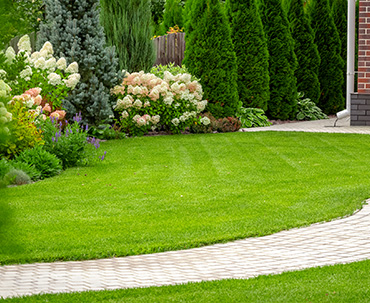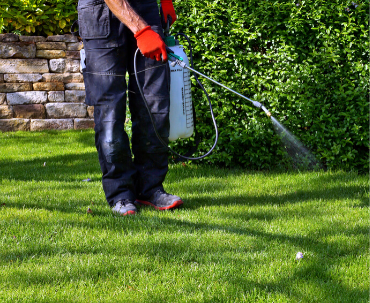Tips
Superior Lawn Care offers these tips for home and business owners who would like to know more about how to care for and maintain their lawn and landscaping. The more that you know about your lawn, the better we can help you throughout the seasons.
Lawn Care Tips
Mowing
That’s called scalping. It should be avoided because it can make your grass thin out, lose color, and introduce more weeds and crabgrass. If a lawn is scalped during the hot summer, it will look yellow and burned out.If your lawn is mowed properly, it will be healthier, have a deeper color, be more resistant to disease and insects, and be less likely to be taken over by weeds.
Your blades should be sharpened by a specialist at least three times a year, especially if you live in an area that gets a lot of rain and therefore a lot of growth. A sharp blade means a deeper green color and clean cut.
Mow the most often during the spring, when the grass is growing quickly. Even if your grass is high, you should never cut more than 1/3 of the grass blade at once. You shouldn’t mow when it’s very wet or hot outside.
The mower height is adjustable for a good reason. When you cut your grass, your mower height should be between 2 1/2 -3″ for the whole year, except during the last cut of the season, when the blade should be at 1 1/3″. This helps keep your grass healthy during the winter by reducing snow mold and matting.
Watering
Your grass will lose color and wilt, and when you mow the lawn, you will notice that the lawn stays matted.
If your lawn is well-established, water about 1 inch each week. One or two deep waterings every week is recommended to encourage better root growth. You can use the seasons to determine how long to water – not as much in the spring, but more in the summer.
It’s best to water in the early morning, because it means that more water will penetrate into the soil, and allow less evaporation throughout the day. While many people prefer to water in the evening, your soil won’t dry enough before nightfall, which can introduce disease.
Core Aeration
Perforating the soil and mechanically removing small plugs of soil and thatch.The process allows:
- Air, water and nutrients to more easily reach the roots of grass plants
- Reduces thatch layer
- Develops stronger and deeper grass root systems
- Loosens compacted soil
Aeration combined with overseeding will provide a stable environment for growth.
Tree and Shrub Care Tips
Pruning
Many types of plants, trees, and shrubs should be pruned in the spring. However, flowering plants must be pruned before there is new growth, so that means by early spring or even in the winter. Deciduous trees can be pruned in September or October to avoid the sap that will flow from the tree if pruning is done in the spring. Done properly, with sharp blades and clean cuts, your vegetation will look great for the spring and summer.
Winter Stress Tips
Desiccation
There are two types of snow mold that we typically see–gray and pink. These diseases appear as circular patches on your lawn that will be brown to tan with either a gray or pink tint. In a typical winter, these patches usually damage only the leaf tissues of the grass, and will they will recover in the spring after you’ve mowed your grass a few times. However, especially cold winters may cause permanent damage to your grass.
You can help your turf recover more quickly by:
- Lightly raking the matted patches with a leaf rake to improve air circulation.
- Properly fertilizing your grass.
- Reseed in areas that have been permanently damaged with high-quality seed.
How Can You Keep Your Lawn and Vegetation Healthy During a Pittsburgh Winter?
- Fertilize the trees and shrubs in the fall to help maintain good plant vigor and health.
- Keep plants watered as winter approaches, especially young plants, transplants,and exposed evergreens.
- Maintain soil moisture by mulching at a 2 to 3″ depth.
- Prune damaged or dead wood in the spring after plants break dormancy.
Western Pennsylvania’s climate often causes “sun scald,” which occurs when the plant tissue is frozen-usually overnight-and then the sun heats the tissue and thaws it out. When the temperature drops below freezing again-usually when the sun goes down-and the cycle keeps happening over several days, sun scald can occur.The signs of sun scald include browning or blackening leaves, split bark, and a plant that looks as though it is in distress.
Frost damage is common in the Pittsburgh area. It causes plant leaves and twigs to blacken, curl, and drop. If the frost damage is a severe case, it will kill buds, flowers, and foliage. If plants are hardy, they should recover from this damage. Sometimes, customers think that “spray damage” looks like frost damage, but they are not the same.
You will see the tips of the leaves look burned, the leaves are wilted or brown, and they may start falling off the plant. If you see desiccation, you should:
- Mulch around the plant to retain moisture.
- If the plant is exposed, use burlap to protect the soil.
- Prune dead branches.
- Make sure the plant has the nutrients it needs to stay healthy. Superior Lawn Care has a root fertilization program offered in the fall that can help.
- Trees and shrubs should be in areas where they aren’t exposed.
Also, called winter burn, desiccation is what happens when plant leaves continue to lose water when the soil is dry or frozen. Certain plants, like azaleas, hollies, and rhododendrons, are prone to desiccation.

Superior Services
Superior’s treatment programs include residential and
commercial services for:










